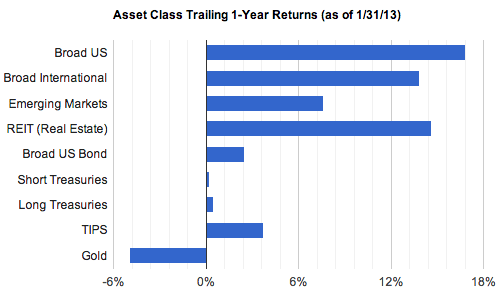Trailing Return What it is and How to Use it
Post on: 16 Март, 2015 No Comment

One criterion that I look at is trailing return. Trailing return is the return that the fund has achieved over the specified time period, including both capital gains and dividend growth.
I like to use this as one of my criterions as it will show you how much money they have made and you can compare this to the other funds that are investing in the same category. So what exactly should you be looking at?
How is Trailing Return Calculated
First it helps to understand how they are calculating the trailing return. It is determined by looking at the Net Asset Value of a mutual fund (the price) at the beginning of the time period compared to the end of the time and then determining the percentage change.
For example: if the fund started with a value of $5 and ended at $7 the change would be calculated as follows:
(Value today – original value)/original value = return*100
Thus (7-5)/5 = .4*100 = 40% Trailing Return
You would also include any dividend that would be reinvested or expenses that would lower your return.
What to Look For
I compare this trailing return to both the category average and the index that is a best match for the category that I am investing in.
When looking at the category average you are trying to determine how a particular fund is performing compared to other funds trying to achieve the same goals in the same area. So if the category average is 10% but the fund you are considering has a return of 5% you may want to keep looking in that category for a better fund. Many times the comparison will be shown as what your fund is above or below the category. So in our numbers above it would actually be presented to you as the fund is -5% to the category.
When looking at the trailing return compared to the index I am mainly looking to see if the fund can outperform the index. If it cannot it may be better to invest in an index mutual fund following that index. The costs are cheaper so if the returns are the same there may not be a compelling reason to invest in the managed fund. I don’t have an exact number above the market that I am looking for since other factors come in to play with an actively managed fund. For example if everything else looks good and they are just have a bad year, then I may move forward with the actively managed fund.
Other Things to Consider with Trailing Returns

Does Not Predict Future
As with any investment the past performance does not tell you what it is going to do in the future. Just because they made money yesterday does not mean they will make money today. This is why it is important to look at the fund as a whole instead of just basing your decisions on return.
Trailing Return May Not be Your Return
Trailing returns look at a very specific snapshot in time. This return may not (and probably won’t) replicate your return. Typically your return is different due to fees and timing of your investment.
Typically when calculating the trailing return investment sites will take into consideration the management fees . What they don’t always take into account is load fees and any fees that you pay separately to purchase the fund. If your brokerage company charges you $20 to buy into the fund then that will take away from your returns.
Your timing on when you buy into a fund and when you sell will determine your return for the future. For example if you purchase your fund on January 4 th but the fund had most of their gains on the 2 nd and 3 rd. then when you get to the end of the year your returns will not match the returns for the year. For an exact number on what your return is you need to be tracking your exact investments.
As always, trust your instinct while gathering as much hard evidence as possible. Happy Investing.














